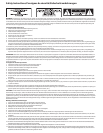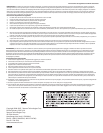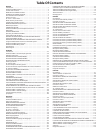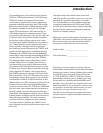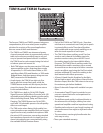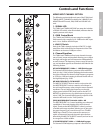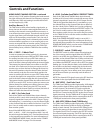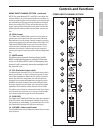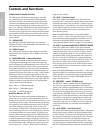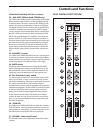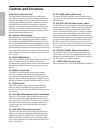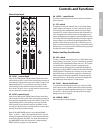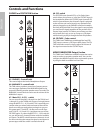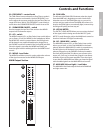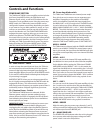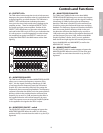
STEREO INPUT CHANNEL SECTION
The TXM16 and TXM20 feature stereo input channels
for connected stereo line level devices like keyboards
and drum machines, as well as the outputs from effects
processors and digital guitar modelers. The TXM 16 has
two sets of stereo inputs which make up channels 9/10
and 11/12, while the TXM20 has four sets of stereo inputs
which make up channels 9/10, 11/12, 13/14 and 15/16.
The Stereo input channels have a three-band fixed equal-
izer and AUX and EFX sends and are laid out the same as
the mono inputs. The following section details the stereo
input controls:
15 – SIGNAL LED
The TXM16 and TXM20’s Stereo Input also includes a
SIGNAL LED which, when illuminated, indicates that a sig-
nal is present at the input.
16 - GAIN Control
The TXM16 and TXM20’s pre-amp stage has a variable
GAIN control with a range of -20 to +20dB on the stereo
LINE input.
17 - HIGH/MID/LOW - Channel Equalizer
The TXM16 and TXM20 Stereo input channels feature a
3-band equalizer allowing you to adjust the high, mid,
and low frequencies independently on each channel. The
stereo channel equalizer is laid out like a mono input on
the control panel input strip, but internally, the equalizer
is affecting a stereo signal path. The channel’s frequency
response is flat when the knobs are in the “12:00” position.
Rotating the knob towards the right will boost the cor-
responding frequency band by 12dB/15dB, and rotating it
towards the left will cut the frequency by 12dB/15dB. The
frequency centers, range of boost or cut, and equalizer
type for each band are as follows:
High: 12kHz +/- 15dB shelving type
Mid: 2.5kHz +/- 12dB peaking type
Low: 80Hz +/- 15dB shelving type
Auxiliary Busses ( 18 - 22 )
The TXM series include several auxiliary signal paths, or
buses, that can be used to create independent mixes for
sending to the internal or external effects processors, or to
an external monitor system. These buses start by sending
the signal from each individual channel, which is set with
one of the auxiliary control knobs. Then, the mix of all
the channels auxiliary level is ultimately sent to either an
internal effects processor, or to an output jack to connect
to an external effect or monitor system. To help you con-
trol your effects and monitor mixes, the TXM16 has three
auxiliary buses, while the TXM20 has four auxiliary buses.
In order to operate your mixer correctly it is important to
understand the concept of PRE and POST fader sends. For
more information on Pre and Post aux sends, see the pre-
vious section “Pre…?, Post?… What’s that?” Located on
page 4 of this manual.
18 – AUX 1- Pre Fader Send
Each of the TXM16 and TXM20’s stereo input channels
include an AUX 1 send, which controls the amount of that
channel’s signal that is sent to the AUX 1 Output. The sig-
nal feeding Aux 1 is sent before, or pre, the channel Fader,
so the channel Fader has no effect on the Aux 1 level. The
Aux 1 bus is usually used to create a separate mix for a
floor monitor system.
Note: If the AMP MODE switch is set to either MONO - -
AUX 1, or AUX 1 - - AUX 2, the signal from AUX 1 bus will
be sent directly to the internal power amplifier. For more
information on the AMP MODE switch see the section
“Using the AMP MODE Switch” on page 12 in this manual.
19 – AUX 2 - Pre Fader Send TXM16 / PRE/POST TXM20
Each of the TXM16 and TXM20’s stereo input channels
include an AUX 2 send, which controls the amount of that
channel’s signal that is sent to the AUX 2 Output. On the
TXM16, the signal that feeds Aux 2 is sent before, or pre,
the channel Fader, so the channel Fader has no effect on
the Aux 2 level. On the TXM20, Aux 2 can be configured
for pre or post fader send using the PRE/POST switch. The
Aux 2 bus is usually used to create a separate mix for a
floor monitor system, but you can set the Pre/Post switch
on the TXM20 to Post to use the send as an effects bus to
an external processor
Note: If the AMP MODE switch is set to AUX 1 - - AUX 2, the
signal from AUX 2 bus will be sent directly to the internal
power amplifier. For more information on the AMP MODE
switch see the section “Using the AMP MODE Switch” on
page 12 in this manual.
20 - PRE/POST - switch (TXM20 only)
The PRE/POST switch is used to select the point that the
Aux 2 bus uses to send the signal. When the PRE/POST
switch is set to PRE, the signal feeding Aux 2 is sent before
the fader, so the channel Fader has no effect on that level.
This is the normal setting when using Aux 2 as a monitor
send. When the PRE/POST switch is set to POST, the signal
feeding Aux 2 is sent after the fader, so the channel Fader
has an effect on that level, meaning the Aux level tracks
up and down with the channel Fader. This is the normal
setting for using Aux 2 as an effects send, since when you
set the channel louder, you normally want the effect to
get louder.
21 – AUX 3/EFX1 - Post Fader Send
The TXM16 and TXM20 provides high quality, 24 Bit digital
effects, and the level of effects can be set independently
on each channel. The stereo channel’s EFX knob controls
the amount of signal that is sent to the EFX bus. The signal
of the EFX bus is routed to the DSP EFX section for on-
board signal processing. On the TXM20, the EFX1 signal
can also be sent to an external effect device connected to
the EXF 1 SEND jack located on the front panel jack field.
Controls and Functions
ENGLISH
6



